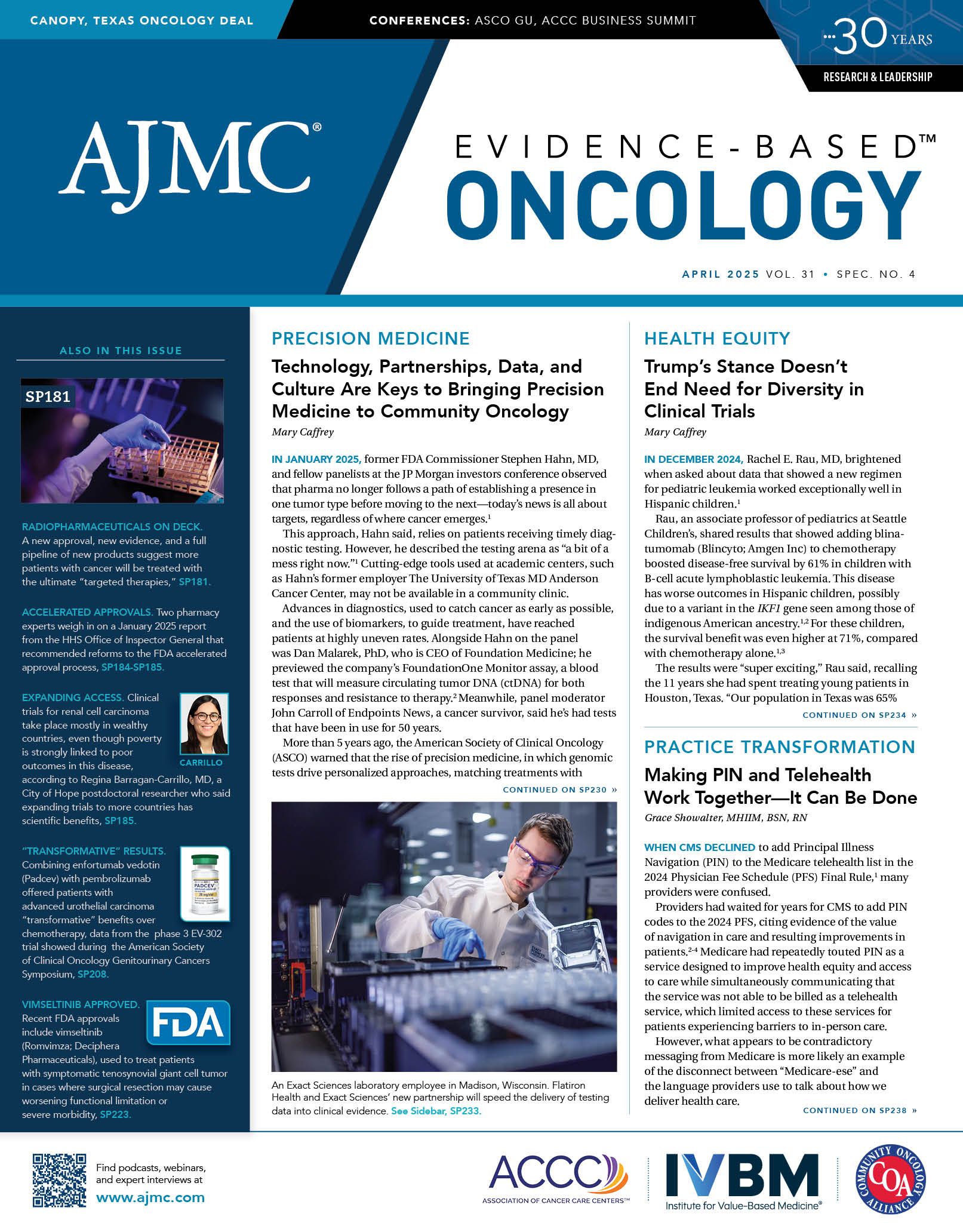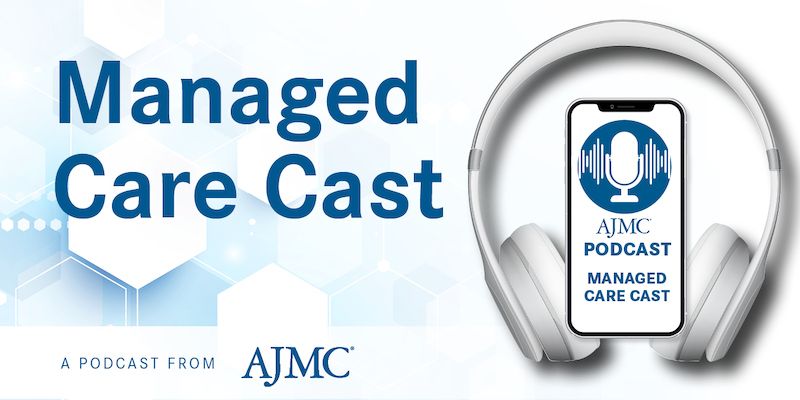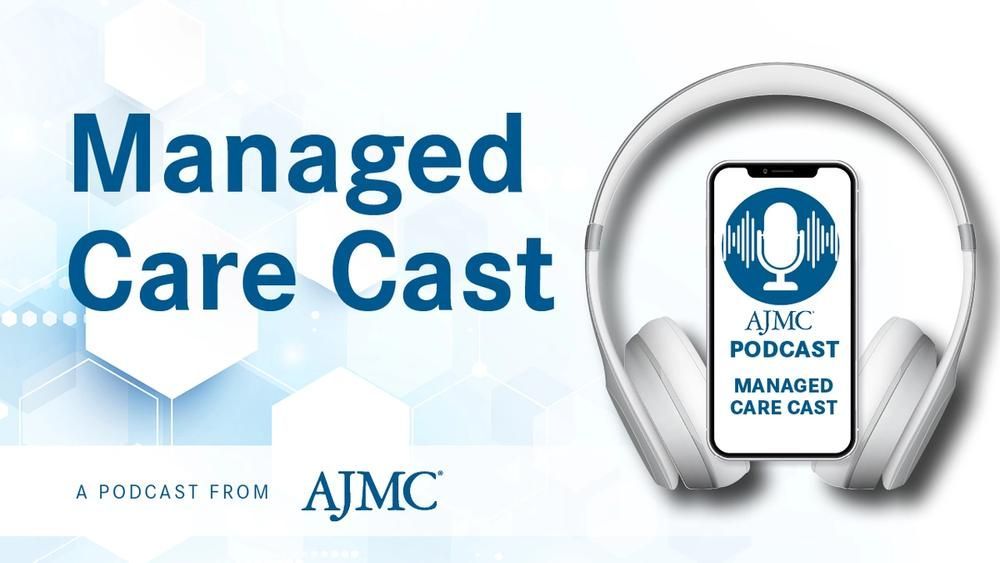Commentary
Article
Evidence-Based Oncology
Making PIN and Telehealth Work Together—It Can Be Done
Author(s):
When CMS declined to add Principal Illness Navigation (PIN) to the Medicare telehealth list in the 2024 Physician Fee Schedule (PFS) Final Rule,1 many providers were confused.
Grace Showalter MHIIM, BSN, RN | Image credit: Vitruvian Consulting

Providers had waited for years for CMS to add PIN codes to the 2024 PFS, citing evidence of the value of navigation in care and resulting improvements in patients.2-4 Medicare had repeatedly touted PIN as a service designed to improve health equity and access to care while simultaneously communicating that the service was not able to be billed as a telehealth service, which limited access to these services for patients experiencing barriers to in-person care.
However, what appears to be contradictory messaging from Medicare is more likely an example of the disconnect between “Medicare-ese” and
the language providers use to talk about how we deliver health care.
A Communication Gap
To be clear, health care providers and any community-based organizations they contract with to provide PIN can unequivocally utilize telephone and telehealth technology to render PIN services. When billing for PIN services that utilize telephone and telehealth technology, they are not billed as telehealth services.
CMS has been explicit, stating in a health-related social needs frequently asked questions document on Community Health Integration (CHI), PIN, and PIN-Peer Support (PS) that “CHI, PIN, and PIN-PS can be performed using telecommunications technology…[and] it was not necessary to add these services to the Medicare Telehealth Services List.”5
To understand this paradox, we first need to understand what Medicare means when the agency labels a service as a telehealth service.
Federal regulations codify the definition of telehealth that Medicare must follow.6 In brief, Medicare telehealth is a technology that enables real-time (synchronous) interactive audio and visual between the patient and provider. When the provider is technologically capable of providing this interactive audio-video technology, but the patient does not consent to, or is not technically capable of, using interactive video, interactive audio-only technology (telephone) can fulfill the telehealth technology requirement for approved services.
However, the services approved for the Medicare Telehealth Services list7 aren’t simply those that can safely and effectively be delivered via telecommunications technology; they are those that pass a 5-step review and approval process from Medicare. Criteria in each step must be satisfied before proceeding to the next step. Medicare explains the review process in detail in their Review Criteria, published on the CMS website and in the Physician Fee Schedule.8 A brief review of the process follows.
Step 1. Determine whether the service is separately payable under the PFS.
If the service is not approved for payment under the Medicare Physician Fee Schedule, it cannot be approved as a Medicare telehealth service.
Step 2. Determine whether the service is subject to the provisions of section 1834(m) of the Act.
Not every service paid under the Physician Fee Schedule is subject to the Act that regulates telehealth. To be considered a potential telehealth service, “at least some elements of the service, when delivered via telehealth, are a substitute for an in-person, face-to-face encounter, and, all of [the] face-to-face elements of the service are furnished using an interactive telecommunications system…”8 By CMS definition, a service can only be considered a telehealth service if telecommunication technology is used to replace an inherently face-to-face patient interaction. Services that are not inherently face-to-face do not meet the threshold to be subject to the Act and are not appropriate to include on the telehealth list.
Step 3. Review the elements of the service as described by the HCPCS [Healthcare Common Procedure Coding System] code and determine whether each of them is capable of being furnished using an interactive telecommunications system as defined in 410.78(a)(3).9
CMS reviews the long description of the HCPCS code, identifies the required elements of the service, and evaluates whether the nonoptional elements can be rendered via interactive audio-visual technology. Optional elements of the service are not evaluated.
Step 4. Consider whether the service elements of the requested service map to the service elements of a service on the list that has a permanent status described in final rulemaking.
CMS examines each required element of the service (as identified in step 3) to determine if a permanently approved telehealth service already exists that contains that individual element. In short, has CMS already determined that the individual required elements are safe and effective when provided via telehealth technology?
Step 5. Consider whether there is evidence of clinical benefit analogous to the clinical benefit of the in-person service when the patient, who is located at a telehealth originating site, receives a service furnished by a physician or practitioner located at a distant site using an interactive telecommunications system.
CMS reviews evidence to determine if patients receive the same benefit when a service is rendered via telehealth as they do when it is provided in person.
In the 2024 Final Rule, CMS explained the reasoning for not adding PIN to the Telehealth List.1 While CMS makes payment for PIN services, satisfying the first step, these services do not satisfy step 2 criteria. CMS included this logic in the Rule: “The elements of the individual services in the code descriptors may not typically require a face-to-face interaction, and therefore PIN (G0023, G0024, G0140, and G0146) and CHI (G0019, G0022) would not be considered as potential Medicare telehealth services under section 1834(m) of the Act.” Because PIN is not an inherently face-to-face service, it cannot be considered a telehealth service.
This is not unique. CMS has used this same reasoning to explain why other care management services such as Chronic Care Management (99490) and Principal Care Management (99424) are not on the Telehealth List. Digital E/M visits (99421-99423), Virtual Check-Ins (G2012), Ambulatory Blood Pressure Monitoring (93784, 93786, 93788, and 93790), Remote Patient Monitoring (99453, 99454, 99457, and 99458), and e-Consults (99446–99452) are all services that do not—and cannot—appear on the Telehealth List.
However, just because a service is not considered a telehealth service does not mean that telecommunications technology may not be utilized to render the care described in the HCPCS code. For instance, Chronic Care Management (CCM) and Principal Care Management (PCM) are well known to include telephonic care to patients, as well as care that does not include patient interaction, such as communication with other care providers. In the Final Rule, CMS clarifies that “the possible use of asynchronous communications technology to support the provision of [PIN] services suggests that our policies for other communications-based technology services should apply instead.”1 In subsequent clarifying documentation,5 CMS states, “CHI, PIN, and PIN-PS can be performed using telecommunications technology. Because these services are ordinarily furnished outside of an in-person, face-to-face visit, they are outside the scope of Medicare telehealth services, like other care management services. For this reason, it was not necessary to add these services to the Medicare Telehealth Services List.”
Use Technology—and Submit Claims
Providers can and should utilize telecommunications technology—whether telehealth, telephone, patient portal messages, secure text messages, or otherwise—to furnish navigation services to patients. When submitting claims, it is not necessary to amend the HCPCS code with modifier -93 or -95 because PIN is not billed as a telehealth service.
This is beneficial to providers. Since PIN services are not subject to telehealth rules, they are free of the statutory limitations on telehealth, including rurality requirements for patient eligibility and the necessity for patients to be located at an approved Originating Site when receiving services. If Congress does not act to extend flexibilities or create more permanent expansions to Medicare telehealth access by March 31, 2025, PIN and other care management services will not be impacted. Patients can continue to receive these services regardless of where they live and where they are when they receive communications from the care team.
This does not mean there aren’t other challenges to implementing PIN in practice, but we have successfully integrated PIN into the options for care management that we utilize in our dementia clinic. When discussing PIN implementation with other providers, there are several common misconceptions and workflow considerations that have prevented care teams from receiving reimbursement for this important care.
A common misunderstanding is that PIN is for patients with a serious diagnosis; providers may wait to enroll patients in PIN until a diagnosis of a serious condition is made. However, in the 2024 Final Rule, CMS clarifies that “a definitive diagnosis is not required before the practitioner makes a clinical determination that the patient has a serious high-risk condition.”1 While they give examples of suspected or confirmed conditions that are likely to benefit from PIN, including cancer, dementia, heart failure, and HIV/AIDS, they leave the determination that a condition is serious and high risk to the clinical judgment of the provider. The condition, whether suspected or confirmed, must meet the following parameters:
- The condition is expected to last at least 3 months.
- The condition places the patient at risk of hospitalization, nursing home placement, acute exacerbation/decompensation, functional decline, or death.
- The condition requires development, monitoring, or revision of a disease-specific care plan.
Providers are sometimes confused about which care management service a patient needs; when a patient is seen at the initiating visit, it may be difficult to ascertain the patient’s exact needs and which care management service will provide the greatest benefit. Some guidelines are clear: If the patient does not have a confirmed qualifying diagnosis or diagnoses, the patient cannot be enrolled in Principal Care Management (PCM) or Chronic Care Management (CCM), leaving PIN as the more appropriate option. When a patient qualifies for multiple services, we have found that the easiest option is to obtain consent for all services that may be applicable to the patient.
Then we ensure the need for navigation is clear in the treatment plan and deliver care according to the patient’s needs with clear documentation in the medical record. At the end of the month, we review the care delivered to the patient and bill for the appropriate service(s).
Providers are also confused about what types of care are appropriate to document as part of PIN. For this, it’s best to look at the long description of the service finalized in the 2024 Rule, which indicates that “tailored support as needed to accomplish the practitioner’s treatment plan” is part of the PIN service.1 This support should address barriers to the treatment plan, which may include:
- Obtaining prior authorization/precertification for services that are part of the treatment plan
- Helping the patient enroll in state, nonprofit, health system, or pharmaceutical financial assistance programs to address costs associated with their care
- Obtaining and sharing medical records
- Locating and/or assisting the patient/caregiver to access resources to overcome transportation difficulties, food insecurity, or other health-related social needs
- Educating the patient/caregiver about the condition and treatment plan
Providing emotional support to help the patient cope with the condition and adjust to new routines - Scheduling appointments or services that are part of the treatment plan
- Addressing questions, concerns, or objections to the treatment plan
Clinically oriented aspects of care, such as medication adjustments and discussion of the patient’s adverse effects of treatment, may be a part of navigation but are better represented by other care management services, such as PCM.
A final barrier to PIN is patient cost sharing. Like all forms of care management, cost sharing for PIN is required in traditional Medicare, but patient contributions are set at 20%, subject to the deductible. For 2025, the Part B deductible is $257.10 Nationally, the average nonfacility co-pay for PIN services is $15.59 for the first 60 minutes of care each month, and $9.70 for each additional 30 minutes of care in the month. While Medicare Advantage plans may have alternative cost-sharing requirements, they are prohibited from charging drastically more than what is charged in traditional Medicare.
These plans may even waive cost sharing for select care management services. High patient cost sharing is more typical when patients are insured through a commercial or employer-sponsored plan, which may not cover or may require higher patient cost sharing for Medicare-specific services. Providers may need to contact individual plans to determine the best way to bill for navigation or negotiate a condition-specific management code or payer-specific navigation code for billing these services.
Medicare’s approach to PIN services provides significant opportunity for providers to receive reimbursement for navigation while working to improve access to care and ensure a coordinated care experience. The flexibility Medicare has allowed to render these services using a variety of telecommunication technologies reflects their commitment to health equity.
Author Information
Grace Showalter MHIIM, BSN, RN, is the founder and CEO of Vitruvian Consulting Group and Mindful Integrative Medicine, both based in Danville, Pennsylvania. Showalter helps health care organizations manage the revenue cycle so they can deliver appropriate patient care while maintaining fiscal stability and care team satisfaction. With expertise in population health, value-based care, and Medicare reimbursement, she advises providers and digital health companies on ways to address patient need, clinical workflows, and reimbursement requirements, with a focus on serving the primary care population.
References
1. Medicare and Medicaid Programs; CY 2024 Payment Policies Under the Physician Fee Schedule and Other Changes to Part B Payment and Coverage Policies; Medicare Shared Savings Program Requirements; Medicare Advantage; Medicare and Medicaid Provider and Supplier Enrollment Policies; and Basic Health Program. Fed Regist. 2023;88:78818-80047. https://www.federalregister.gov/documents/2023/11/16/2023-24184/medicare-and-medicaid-programs-cy-2024-payment-policies-under-the-physician-fee-schedule-and-other
2. Pitter JG, Moizs M, Ezer ES, et al. Improved survival of non-small cell lung cancer patients after introducing patient navigation: a retrospective cohort study with propensity score weighted historic control. PLoS One. 2022;17(10):e0276719. doi:10.1371/journal.pone.02767193.
3. Chan RJ, Milch VE, Crawford-Williams F, et al. Patient navigation across the cancer care continuum: an overview of systematic reviews and emerging literature. CA Cancer J Clin. 2023;73(6):565-589. doi:10.3322/caac.21788
Li C, Liu Y, Xue D, Chan CWH. Effects of nurse-led interventions on early detection of cancer: a systematic review and meta-analysis. Int J Nurs Stud. 2020;110:103684. doi:10.1016/j.ijnurstu.2020.103684
4. Health-related social needs FAQ. CMS. Accessed March 17, 2025. https://www.cms.gov/files/document/health-related-social-needs-faq.pdf
Telehealth Services. 42 CFR § 410.78 (2025). https://www.ecfr.gov/current/title-42/chapter-IV/subchapter-B/part-410/subpart-B/section-410.78
5. List of telehealth services. CMS. Updated December 11, 2024. Accessed March 19, 2024. https://www.cms.gov/medicare/coverage/telehealth/list-services
6. CMS review criteria. CMS. Updated September 10, 2024. Accessed March 19, 2025. https://www.cms.gov/medicare/coverage/telehealth/criteria-request
7. Interactive telecommunications system. 42 CFR § 410.78(a)(3) (2025). https://www.ecfr.gov/current/title-42/chapter-IV/subchapter-B/part-410/subpart-B/section-410.78#p-410.78(a)(3)
8. Costs. Medicare.gov. Accessed March 19, 2025. https://www.medicare.gov/basics/costs/medicare-costs


Navigating Sport-Related Neurospine Injuries, Surgery, and Managed Care




